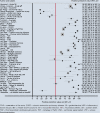Validity of diagnostic coding within the General Practice Research Database: a systematic review
- PMID: 20202356
- PMCID: PMC2828861
- DOI: 10.3399/bjgp10X483562
Validity of diagnostic coding within the General Practice Research Database: a systematic review
Abstract
Background: The UK-based General Practice Research Database (GPRD) is a valuable source of longitudinal primary care records and is increasingly used for epidemiological research.
Aim: To conduct a systematic review of the literature on accuracy and completeness of diagnostic coding in the GPRD.
Design of study: Systematic review.
Method: Six electronic databases were searched using search terms relating to the GPRD, in association with terms synonymous with validity, accuracy, concordance, and recording. A positive predictive value was calculated for each diagnosis that considered a comparison with a gold standard. Studies were also considered that compared the GPRD with other databases and national statistics.
Results: A total of 49 papers are included in this review. Forty papers conducted validation of a clinical diagnosis in the GPRD. When assessed against a gold standard (validation using GP questionnaire, primary care medical records, or hospital correspondence), most of the diagnoses were accurately recorded in the patient electronic record. Acute conditions were not as well recorded, with positive predictive values lower than 50%. Twelve papers compared prevalence or consultation rates in the GPRD against other primary care databases or national statistics. Generally, there was good agreement between disease prevalence and consultation rates between the GPRD and other datasets; however, rates of diabetes and musculoskeletal conditions were underestimated in the GPRD.
Conclusion: Most of the diagnoses coded in the GPRD are well recorded. Researchers using the GPRD may want to consider how well the disease of interest is recorded before planning research, and consider how to optimise the identification of clinical events.
Figures
Comment in
-
Case validation in research using large databases.Br J Gen Pract. 2010 Mar;60(572):160-1. doi: 10.3399/bjgp10X483472. Br J Gen Pract. 2010. PMID: 20202361 Free PMC article. No abstract available.
-
Validity of diagnoses in the general practice research database.Br J Gen Pract. 2011 Jul;61(588):438-9. doi: 10.3399/bjgp11X583092. Br J Gen Pract. 2011. PMID: 21722461 Free PMC article. No abstract available.
References
-
- Jordan K, Porcheret M, Kadam UT, Croft P. The use of general practice consultation databases in rheumatology research. Rheumatology (Oxford) 2006;45(2):126–128. - PubMed
-
- Walley T, Mantgani A. The UK General Practice Research Database. Lancet. 1997;350(9084):1097–1099. - PubMed
-
- Medicines and Healthcare products Regulatory Agency. GPRD recording guidelines for vision users. London: Crown Copyright; 2004.
-
- Medicines and Healthcare products Regulatory Agency. Data quality assessment in GPRD. London: Crown Copyright; 2007.
Publication types
MeSH terms
Grants and funding
LinkOut - more resources
Full Text Sources
Research Materials


